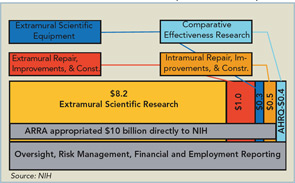“There wasn’t one single avenue for getting the money,” he says. “Some institutes took the money and looked at their backlog of unfunded projects. Some used administrative supplements to fund previously committed projects at higher levels. Many used a number of different approaches.”
There were at least two major challenges seen by researchers in the language of the ARRA. One was that all money had to be spent within two years. The second was a short deadline for submitting proposals.
Two-year Funding
“Most rigorously scientific projects will not fit well into a two-year time period,” noted Daniel Lovell, MD, professor of pediatrics at the Cincinnati Children’s Hospital Medical Center. “The upside is that it allowed researchers to focus on developing mechanisms and approaches that potentially could change the face of medical research if follow-up funding is available. They are building consortiums and capabilities to do longer term large studies.”
Dr. Carter acknowledges that this was a concern and limited the projects that could be funded. “In our experience, it is very hard to do any kind of real clinical trial within that timeframe,” he says. “Usually just getting all the things like study design, Institutional Review Board approval, and getting regulatory okays means 18 months pass before you can begin patient accrual. In the language of the RFA, we tried to make it clear we were discouraging clinical trials without some very compelling reason to think it could be completed quickly.”
Large Numbers of Applicants
Despite the short timeline, the ARRA grants had no shortage of applicants. For example, one of the smaller funded mechanisms, the Challenge Grants, drew around 20,000 applications for $200 million in grants available throughout the NIH.
Michael Holers, MD, head of the division of rheumatology at the University of Colorado in Denver decided to not participate in the ARRA program. He summed up many of the problems voiced. “No one from this department, including me, decided to participate directly, and I suspect these decisions were based on many factors,” he says. “I think that the reasons would include the published scope of the ARRA grants, the time available to write a grant versus [time] needed for other commitments, the likelihood of a successful application with the anticipated number of funded proposals versus the expected number of submissions, other personal and professional commitments, and the availability of other grant sources to support a faculty member’s research that might have otherwise gone in the ARRA.”

